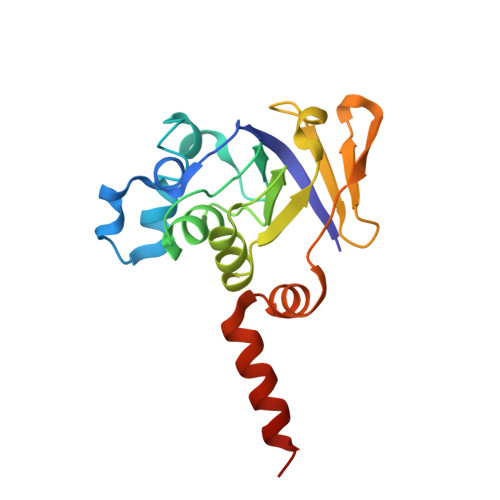Substrate specificity determinants of the methanogen homoaconitase enzyme: structure and function of the small subunit
Jeyakanthan, J., Drevland, R.M., Gayathri, D.R., Velmurugan, D., Shinkai, A., Kuramitsu, S., Yokoyama, S., Graham, D.E.(2010) Biochemistry 49: 2687-2696
- PubMed: 20170198
- DOI: https://doi.org/10.1021/bi901766z
- Primary Citation of Related Structures:
2PKP - PubMed Abstract:
The aconitase family of hydro-lyase enzymes includes three classes of proteins that catalyze the isomerization of alpha-hydroxy acids to beta-hydroxy acids. Besides aconitase, isopropylmalate isomerase (IPMI) proteins specifically catalyze the isomerization of alpha,beta-dicarboxylates with hydrophobic gamma-chain groups, and homoaconitase (HACN) proteins catalyze the isomerization of tricarboxylates with variable chain length gamma-carboxylate groups. These enzymes' stereospecific hydro-lyase activities make them attractive catalysts to produce diastereomers from unsaturated precursors. However, sequence similarity and convergent evolution among these proteins lead to widespread misannotation and uncertainty about gene function. To find the substrate specificity determinants of homologous IPMI and HACN proteins from Methanocaldococcus jannaschii, the small-subunit HACN protein (MJ1271) was crystallized for X-ray diffraction. The structural model showed characteristic residues in a flexible loop region between alpha2 and alpha3 that distinguish HACN from IPMI and aconitase proteins. Site-directed mutagenesis of MJ1271 produced loop-region variant proteins that were reconstituted with wild-type MJ1003 large-subunit protein. The heteromers formed promiscuous hydro-lyases with reduced activity but broader substrate specificity. Both R26K and R26V variants formed relatively efficient IPMI enzymes, while the T27A variant had uniformly lower specificity constants for both IPMI and HACN substrates. The R26V T27Y variant resembles the MJ1277 IPMI small subunit in its flexible loop sequence but demonstrated the broad substrate specificity of the R26V variant. These mutations may reverse the evolution of HACN activity from an ancestral IPMI gene, demonstrating the evolutionary potential for promiscuity in hydro-lyase enzymes. Understanding these specificity determinants enables the functional reannotation of paralogous HACN and IPMI genes in numerous genome sequences. These structural and kinetic results will help to engineer new stereospecific hydro-lyase enzymes for chemoenzymatic syntheses.
- Life Science Group, National Synchrotron Radiation Research Center, 101 Hsin-Ann Road, Hsinchu Science Park, Hsinch 30076, Taiwan.
Organizational Affiliation:


















